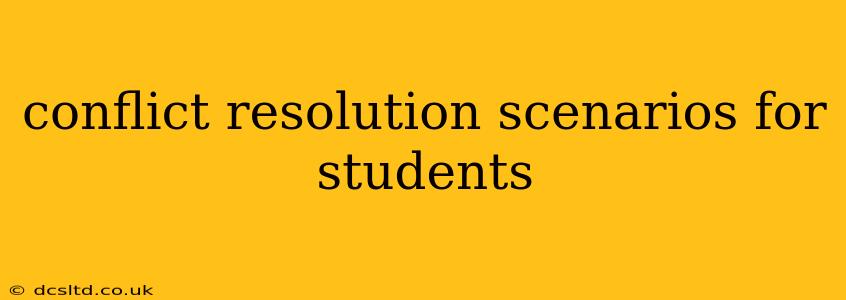Conflict is an inevitable part of life, and learning to resolve disagreements constructively is a crucial life skill. For students, this means navigating disagreements with peers, teachers, and even family members. This article explores various conflict resolution scenarios for students, offering practical strategies and techniques for peacefully resolving disputes. We'll cover scenarios ranging from minor disagreements to more serious conflicts, providing tools students can utilize to become effective conflict resolvers.
What are some common conflict resolution scenarios for students?
Common conflict scenarios for students often revolve around:
- Sharing and resources: Disagreements over toys, materials, or spaces. This is particularly prevalent in younger age groups.
- Academic work: Conflicts regarding group projects, collaborative assignments, or perceived unfairness in grading.
- Social dynamics: Bullying, exclusion, gossip, and friendship conflicts. These scenarios can be particularly challenging and emotionally charged.
- Classroom behavior: Disagreements with teachers regarding rules, expectations, or disciplinary actions.
- Personal differences: Conflicts arising from differing opinions, beliefs, or values. This can be complex and requires empathy and understanding.
How can students resolve conflicts peacefully?
Peaceful conflict resolution emphasizes communication, empathy, and finding mutually acceptable solutions. Here are some key steps:
-
Identify the problem: Clearly define the issue at hand. What exactly is the disagreement about? Avoid generalizations and focus on specific behaviors or events.
-
Active listening: Listen attentively to the other person's perspective without interrupting. Try to understand their feelings and viewpoint, even if you don't agree.
-
Empathy and perspective-taking: Put yourself in the other person's shoes. How might they be feeling? What are their needs and concerns?
-
Collaborative problem-solving: Work together to brainstorm solutions that meet the needs of everyone involved. Compromise is often key.
-
Negotiation and agreement: Negotiate a mutually acceptable solution. This might involve compromise, trade-offs, or agreeing to disagree respectfully.
-
Follow-up and evaluation: Check in later to see if the solution is working and make adjustments if necessary.
What are some conflict resolution techniques students can use?
Several specific techniques can help students navigate conflicts effectively:
-
"I" statements: Expressing feelings and needs using "I" statements (e.g., "I feel frustrated when...") helps avoid blaming and accusatory language.
-
Role-playing: Practicing conflict resolution scenarios can build confidence and skills.
-
Mediation: A neutral third party can facilitate communication and help find solutions.
-
Assertiveness training: Learning to express needs and boundaries respectfully and confidently is crucial.
-
Conflict resolution strategies: Understanding various strategies like compromise, negotiation, and collaboration empowers students to choose the most appropriate approach for each situation.
How can teachers help students develop conflict resolution skills?
Teachers play a vital role in fostering a positive classroom environment where students learn to resolve conflicts constructively. This can be achieved through:
-
Modeling positive conflict resolution: Teachers should model respectful communication and problem-solving skills in their interactions with students.
-
Providing explicit instruction: Teaching students specific conflict resolution strategies and techniques.
-
Creating opportunities for practice: Incorporating role-playing, simulations, and real-life scenarios into the curriculum.
-
Facilitating peer mediation: Training students to mediate conflicts amongst their peers.
-
Promoting a culture of respect and empathy: Establishing classroom rules and expectations that emphasize respect, kindness, and understanding.
What if the conflict involves bullying or harassment?
Bullying and harassment require a different approach than minor disagreements. Students should immediately report such incidents to a trusted adult – a teacher, counselor, or parent. Schools typically have established procedures for addressing bullying, and it's crucial to follow these procedures to ensure the safety and well-being of all students.
How can parents support their children's conflict resolution skills?
Parents can reinforce these skills at home by:
-
Providing opportunities for problem-solving: Encourage children to resolve their own disagreements whenever possible.
-
Modeling positive conflict resolution: Show children how to handle disagreements respectfully and constructively.
-
Active listening and validation: Listen to your child's perspective without judgment.
-
Teaching emotional regulation: Help children manage their emotions in stressful situations.
-
Positive reinforcement: Praise and reward children for using positive conflict resolution strategies.
Learning effective conflict resolution skills is a journey that requires practice and patience. By providing students with the tools and support they need, we can empower them to navigate disagreements constructively and build positive relationships. Remember, the goal is not to eliminate conflict entirely, but to equip students with the skills to manage it effectively and peacefully.
